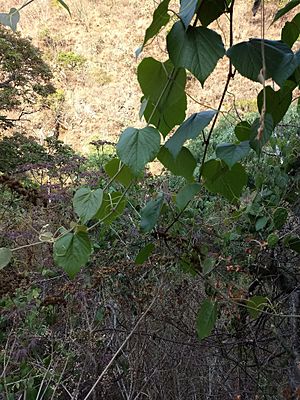Caribbean grape facts for kids
Quick facts for kids Caribbean grape |
|
|---|---|
 |
|
| Scientific classification | |
| Genus: |
Vitis
|
| Species: |
tiliifolia
|
| Synonyms | |
|
Vitis caribaea DC. |
|
The Caribbean grape (scientific name: Vitis tiliifolia) is a type of vine that grows in the Americas. It belongs to the grape family. This plant is also known by other names like West Indian grape, water vine, Agrá, and Bejuco de Agua. In Belizean Creole, people call it water tie-tie or water-wise.
Contents
Where Does the Caribbean Grape Grow?
The Caribbean grape is found in many places across the Americas. It grows naturally in most parts of Mexico. This includes states like Chiapas, Jalisco, Oaxaca, and Yucatán.
You can also find it in many other countries. These include Belize, Colombia, Costa Rica, Cuba, and the Dominican Republic. It also grows in Ecuador, El Salvador, Guatemala, Haiti, Honduras, Jamaica, and Nicaragua. Panama, Puerto Rico, the U.S. Virgin Islands, and St Lucia are also home to this vine.
In Costa Rica, it is most common at altitudes between 500 and 1,000 meters. This means it likes to grow on hillsides and in mountainous areas.
How Is the Caribbean Grape Used?
People use the Caribbean grape in several ways. In Mayan farming, it is grown as a forest crop. This means it is part of their traditional way of growing food in forests.
The vine's fruits can be eaten or made into drinks. They are also used as an ingredient in traditional medicines.
Most Caribbean grape vines have separate male and female plants. This is called dioecious. However, some wild vines have both male and female parts.
The plant usually flowers at the start of the dry season. In the northern hemisphere, this is around December. A single vine can produce up to 20 kilograms (about 44 pounds) of fruit when farmed.
The fruits are small and taste quite sour. They have a low sugar content. Even so, people sometimes make them into wine. This wine is said to taste similar to the Norton grape wine from the USA.
When grown, these vines are very strong and grow quickly. They are similar to Muscadine grapes. They need a lot of space to spread out, about 6 meters (20 feet) of trellis room. Just like other grapes, the Caribbean grape can be pruned. New plants can also be grown from cuttings.
What About Pests?
The Caribbean grape might have a special ability to fight off a disease called Pierce's disease (PD). This disease harms many types of commercial grapes.
Even when the Caribbean grape has a lot of the bacteria that cause PD, it does not show typical symptoms. This suggests it has some natural protection against the disease. The bacteria that causes PD is called Xylella fastidiosa. It is a type of plant pathogen.
See also
 In Spanish: Bejuco blanco para niños
In Spanish: Bejuco blanco para niños

